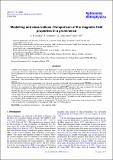Files in this item
Modelling and observations : a comparison of the magnetic field properties in a prominence
Item metadata
| dc.contributor.author | Mackay, Duncan Hendry | |
| dc.contributor.author | Schmieder, Brigitte | |
| dc.contributor.author | Lopez Ariste, Arturo | |
| dc.contributor.author | Su, Yingna | |
| dc.date.accessioned | 2020-05-05T13:30:02Z | |
| dc.date.available | 2020-05-05T13:30:02Z | |
| dc.date.issued | 2020-05 | |
| dc.identifier | 260661765 | |
| dc.identifier | 422d3577-5cbf-4d18-b812-2f9b44181f4f | |
| dc.identifier | 85088148158 | |
| dc.identifier | 000531310300003 | |
| dc.identifier.citation | Mackay , D H , Schmieder , B , Lopez Ariste , A & Su , Y 2020 , ' Modelling and observations : a comparison of the magnetic field properties in a prominence ' , Astronomy & Astrophysics , vol. 637 , A3 . https://doi.org/10.1051/0004-6361/201936656 | en |
| dc.identifier.issn | 0004-6361 | |
| dc.identifier.other | ORCID: /0000-0001-6065-8531/work/73293065 | |
| dc.identifier.uri | https://hdl.handle.net/10023/19882 | |
| dc.description | Funding: UK STFC, ERC, and Leverhulme Trust (DHM). | en |
| dc.description.abstract | Context. Direct magnetic field measurements in solar prominences occur infrequently and are difficult to make and interpret. As a consequence, alternative methods are needed to derive the main properties of the magnetic field that supports the prominence mass. This is important for our understanding of solar prominences, but also for understanding how eruptive prominences may affect space weather. Aims. We present the first direct comparison of the magnetic field strength derived from spectro-polarimetric observations of a solar prominence, with corresponding results from a theoretical flux rope model constructed from on-disc normal component magnetograms. Methods. We first used spectro-polarimetric observations of a prominence obtained with the magnetograph THEMIS operating in the Canary Islands to derive the magnetic field of the observed prominence by inverting the Stokes parameters measured in the He D3 line. Next, we constructed two data-constrained non-linear force-free field (NLFFF) models of the same prominence. In one model we assumed a strongly twisted flux rope solution, and in the other a weakly twisted flux rope solution. Results. The physical extent of the prominence at the limb (height and length) is best reproduced with the strongly twisted flux rope solution. The line-of-sight average of the magnetic field for the strongly twisted solution results in a magnetic field that has a magnitude of within a factor of 1−2 of the observed magnetic field strength. For the peak field strength along the line of sight, an agreement to within 20% of the observations is obtained for the strongly twisted solution. The weakly twisted solution produces significantly lower magnetic field strengths and gives a poor agreement with the observations. Conclusions. The results of this first comparison are promising. We found that the flux rope insertion method of producing a NLFFF is able to deduce the overall properties of the magnetic field in an observed prominence. | |
| dc.format.extent | 14 | |
| dc.format.extent | 7809328 | |
| dc.language.iso | eng | |
| dc.relation.ispartof | Astronomy & Astrophysics | en |
| dc.subject | Sun: filaments, prominences | en |
| dc.subject | Sun: magnetic fields | en |
| dc.subject | QB Astronomy | en |
| dc.subject | QC Physics | en |
| dc.subject | 3rd-DAS | en |
| dc.subject.lcc | QB | en |
| dc.subject.lcc | QC | en |
| dc.title | Modelling and observations : a comparison of the magnetic field properties in a prominence | en |
| dc.type | Journal article | en |
| dc.contributor.sponsor | European Research Council | en |
| dc.contributor.sponsor | Science & Technology Facilities Council | en |
| dc.contributor.sponsor | Science & Technology Facilities Council | en |
| dc.contributor.institution | University of St Andrews. Applied Mathematics | en |
| dc.identifier.doi | 10.1051/0004-6361/201936656 | |
| dc.description.status | Peer reviewed | en |
| dc.date.embargoedUntil | 2020-04-30 | |
| dc.identifier.grantnumber | 810218 | en |
| dc.identifier.grantnumber | ST/S000402/1 | en |
| dc.identifier.grantnumber | ST/N000609/1 | en |
This item appears in the following Collection(s)
Items in the St Andrews Research Repository are protected by copyright, with all rights reserved, unless otherwise indicated.

